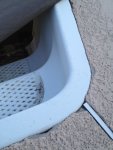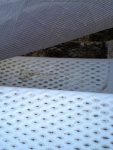Formed a crack in my steps last year, other than acid, anyway of determining which material they are? I heard if the're fiberglass they can be repaired. A local company quoted me $5000 to replace, seems high to me.
Steps
- Thread starter nick1427d
- Start date
You are using an out of date browser. It may not display this or other websites correctly.
You should upgrade or use an alternative browser.
You should upgrade or use an alternative browser.
All types of pool steps can be repaired. Three basic types: gunite/plaster, fiberglass and vinyl liner. The first will be obvious as the surface is very hard and either has plaster or a pebble sheen like surface. Fiberglass will likely be much smoother and feels like a hard plastic. Vinyl pools have a liner over concrete or "vermiculite" and will pull away from the base if you pinch the liner. Any others I'm not aware of?
Post a picture of your steps. 5,000 to replace could seem right since you have to consider that when they replace steps they are ripping up a good chunk of concrete as well and the liner will probably not be salvageable. steps in a liner pool use a gasket and sandwich between the pool vinyl to keep water tight the chances that they can put new steps in and alight the holes in the liner perfectly are slim. Now I've repaired steps using fiberglass (supplies can be found at home depot etc.)
Repairing with fiberglass is kinda like working with paper mache, except usually a 15 minute working time.
You need to clean the steps very well with alcohol
sand the crack and a 2" surrounding area
make sure everything is clean and all the dust from sanding is gone (leaf blower)
have your various sized glass meshes pre-cut and ready to go
mix up your resin and start to apply layers (I would wear 3 pairs of latex gloves and take off a layer as the resin starts to get too sticky to the glove)
use small strips to make sure you can squish out all the air bubbles (the diamond patten in the steps makes it prone to have bubbles, air bubbles will weaken the repair)
I would say I usually use about 5 layers or so tapering to the edges
wait a day until everything is dry
sand sand sand sand (if you don't you'll have to visit the hospital when someone cuts their foot open)
paint the area (or the whole step) white with a two part epoxy paint
let dry and fill up and that's it.
Depending how good you are the repair is usually not noticeable unless looking for it since the diamond pattern on the step will look softened in the repaired area
Repairing with fiberglass is kinda like working with paper mache, except usually a 15 minute working time.
You need to clean the steps very well with alcohol
sand the crack and a 2" surrounding area
make sure everything is clean and all the dust from sanding is gone (leaf blower)
have your various sized glass meshes pre-cut and ready to go
mix up your resin and start to apply layers (I would wear 3 pairs of latex gloves and take off a layer as the resin starts to get too sticky to the glove)
use small strips to make sure you can squish out all the air bubbles (the diamond patten in the steps makes it prone to have bubbles, air bubbles will weaken the repair)
I would say I usually use about 5 layers or so tapering to the edges
wait a day until everything is dry
sand sand sand sand (if you don't you'll have to visit the hospital when someone cuts their foot open)
paint the area (or the whole step) white with a two part epoxy paint
let dry and fill up and that's it.
Depending how good you are the repair is usually not noticeable unless looking for it since the diamond pattern on the step will look softened in the repaired area
Kevin is spot on, and has probably repaired a few Vettes. You might look though the Corvette forums, which may have pictures of repairs (I like pictures) and may explain in a different manner. Two things, get the bubbles out and pack as many layers of mat (not cloth) as you can in. Make sure the fiberglass mat is fully impregnated with the resin. It has been a few years since I have done anything in glass, but I would get some good masks and wear long sleeves when sanding.
You can also get fiberglass and resin at any local autoparts store, wallyworld, etc. In case you want to see an explanation (sorry, no repair pics) http://forums.corvetteforum.com/c3-gene ... tions.html look at zwedes posts.
You can also get fiberglass and resin at any local autoparts store, wallyworld, etc. In case you want to see an explanation (sorry, no repair pics) http://forums.corvetteforum.com/c3-gene ... tions.html look at zwedes posts.
Also checked Youtube for some videos. I accidentally cracked my Jeep's fiberglass top last fall, and for the first time worked with Bondo. Really not to bad. If you want to practice, take a board or cardboard, and lay down the resin, then the mat, then the resin on a small spot just to get a feel of how it goes on. But if you can paint, you can Bondo.
Do you know how it broke? Must not be supported underneath. Must be getting brittle. I'd try a patch first, as described above, and if it happens again well then you might just be needing a replacement set of steps.
It's gonna take some effort to reproduce the texture of the steps, but not impossible. Do you have a dremel tool? Once you make your patch (which will conform somewhat to the steps texture. You can use a cylinder sanding disk thingy http://www.dremel.com/en-us/Accessories ... x?catid=44 to sand the depressions and make the patch dissapear.
I fixed my broken shower seat as described above, including the epoxy paint, the patch has held up but after about 4 years the paint is starting to wear away (not flaking or scratching off, just wearing away as if my butt sanded it....)
It's gonna take some effort to reproduce the texture of the steps, but not impossible. Do you have a dremel tool? Once you make your patch (which will conform somewhat to the steps texture. You can use a cylinder sanding disk thingy http://www.dremel.com/en-us/Accessories ... x?catid=44 to sand the depressions and make the patch dissapear.
I fixed my broken shower seat as described above, including the epoxy paint, the patch has held up but after about 4 years the paint is starting to wear away (not flaking or scratching off, just wearing away as if my butt sanded it....)
never repaired any cars but I did make a diving helmet the first time I fooled around with fiberglass. Anyways, cracks like that are what I usually repair. Those steps could be a plastic or could be fiberglass it's not really easy to tell unless you start dremeling them and find that they are gel coated fiberglass or the plastic is solid all the way through. Regardless I've successfully repaired both with fiberglass. I think they crack if they aren't supported correctly as was mentioned earlier. I attempted to match the diamond patten once but then felt I was taking too much of the strength away from the patch just to make it look a little bit prettier. Once it's painted it will look pretty good. I've used mat (hair like glass that has no real weave) and the cloth (woven material like canvas) I use both sometimes although the more I do it the more I notice that the mat is more mold-able and less likely to form air pockets since the fibers aren't all woven together. You might want to lay the cloth for the top layer though as the smoother you get it to lay the less sanding you'll need to do (those hairs will get sharp like needles)
tip:
When sanding (you'll be doing a lot of sanding)
Try to get it as smooth as possible a trick I do to check for any sharp spots is I take a dry wash cloth and wipe it back and forth in all directions watching for the cloth to catch on anything sharp.
tip:
When sanding (you'll be doing a lot of sanding)
Try to get it as smooth as possible a trick I do to check for any sharp spots is I take a dry wash cloth and wipe it back and forth in all directions watching for the cloth to catch on anything sharp.
Kevin:
Does it make sense to drill a (very) small hole at the ends of the crack to stop the crack from migrating ? I realize this is not an automotive application, but the picture seems to indicate a prior repair and the right side seems to have extended beyond the original repair.
Does it make sense to drill a (very) small hole at the ends of the crack to stop the crack from migrating ? I realize this is not an automotive application, but the picture seems to indicate a prior repair and the right side seems to have extended beyond the original repair.
That might be a good idea. Never did it myself but I do make sure my patch extends at least 2" beyond the crack in both directions. Once though I was able to see through the crack in the steps and see that the steps were supported with pressure treated wood that no longer was flush to the steps. I put some wood screws through the area where I was patching prior to repair and it really snugged everything up. I never did the "drill a hole" thing because I never felt that the cracks had the potential to spread. Most of the time the cracks seem pretty stable on their own almost like the stress was released once the crack forms. I could be wrong, regardless fiberglass is the only thing out there I know of that is strong enough to fix steps and they feel strong afterwards. Plast-aid and AB putty crack off when you step on them.
Thanks for all the tips, just i to give an update.
Today I was having a pool company in area fix my steps ($2300). A "painter" showed up and commented that he had never done pool steps before and was very confused. I asked him what he was going to be using to fix the crack and he showed me a fiberglass repair kit he got at walmart and two-part epoxy paint. I was shocked that I was about to pay 2 grand for something I could do on my own. I was under impression that it was a "special paint" and a "special process". He even told me that it would be impossible for him to match up the diamond tread. A few phone calls later and a trip to the hardware store and I'm officially going to fix it myself.
My question and slight problem. The steps where the crack formed are moving a lot when weight is placed on them. I drilled a 1/2'' hole at current crack and one at other end to see if there were any supports. From what I could see was a space from crack to more plastic/fiberglass. When i stuck a screwdriver in the hole the plastic angles down toward bottom of current cracked step. (I'll try to diagram). I'm going to attempt to fill in the steps with sand and expansion foam but I'm wondering if the sides are open or if there is any space in the steps void. My pool was definitely leaking from the steps so water had to of gone somewhere. Do you think the sand and expansion foam will help with the movement?
Today I was having a pool company in area fix my steps ($2300). A "painter" showed up and commented that he had never done pool steps before and was very confused. I asked him what he was going to be using to fix the crack and he showed me a fiberglass repair kit he got at walmart and two-part epoxy paint. I was shocked that I was about to pay 2 grand for something I could do on my own. I was under impression that it was a "special paint" and a "special process". He even told me that it would be impossible for him to match up the diamond tread. A few phone calls later and a trip to the hardware store and I'm officially going to fix it myself.
My question and slight problem. The steps where the crack formed are moving a lot when weight is placed on them. I drilled a 1/2'' hole at current crack and one at other end to see if there were any supports. From what I could see was a space from crack to more plastic/fiberglass. When i stuck a screwdriver in the hole the plastic angles down toward bottom of current cracked step. (I'll try to diagram). I'm going to attempt to fill in the steps with sand and expansion foam but I'm wondering if the sides are open or if there is any space in the steps void. My pool was definitely leaking from the steps so water had to of gone somewhere. Do you think the sand and expansion foam will help with the movement?
Attachments
- May 26, 2009
- 46
Thanks for all the tips, just i to give an update.
Today I was having a pool company in area fix my steps ($2300). A "painter" showed up and commented that he had never done pool steps before and was very confused. I asked him what he was going to be using to fix the crack and he showed me a fiberglass repair kit he got at walmart and two-part epoxy paint. I was shocked that I was about to pay 2 grand for something I could do on my own. I was under impression that it was a "special paint" and a "special process". He even told me that it would be impossible for him to match up the diamond tread. A few phone calls later and a trip to the hardware store and I'm officially going to fix it myself.
My question and slight problem. The steps where the crack formed are moving a lot when weight is placed on them. I drilled a 1/2'' hole at current crack and one at other end to see if there were any supports. From what I could see was a space from crack to more plastic/fiberglass. When i stuck a screwdriver in the hole the plastic angles down toward bottom of current cracked step. (I'll try to diagram). I'm going to attempt to fill in the steps with sand and expansion foam but I'm wondering if the sides are open or if there is any space in the steps void. My pool was definitely leaking from the steps so water had to of gone somewhere. Do you think the sand and expansion foam will help with the movement?
I'm having the same issue. My pool was here when we moved in and was neglected. Needed a new liner and pump, and the rest was in good shape. But the steps had a deep gouge in them. Eventually that led to a crack. Well using putting the last 3 years to repair it had it has finally spread to become a big crack. The area under this step is now worn away by the water leaking. All the other steps have a solid feel under them, except the area around the crack. A youtube video I watched had them drill what seemed like 2inch holes to backfill the steps with sand. I'm going to drill out mine, back fill the step for support, and then use the bondo repair method.
Thread Status
Hello , This thread has been inactive for over 60 days. New postings here are unlikely to be seen or responded to by other members. For better visibility, consider Starting A New Thread.
Similar threads
- Replies
- 26
- Views
- 533
- Replies
- 4
- Views
- 796
- Replies
- 3
- Views
- 338
- Replies
- 18
- Views
- 780




